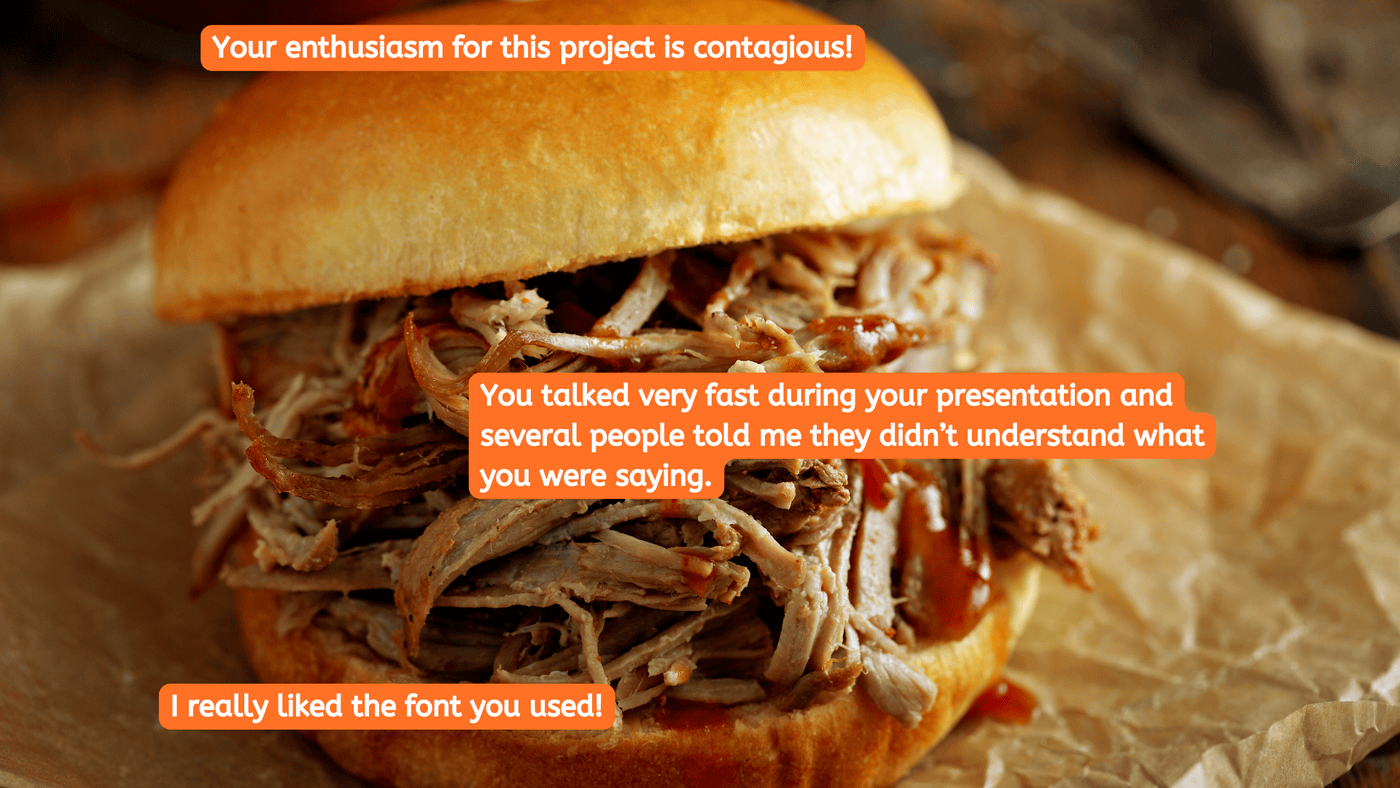The Pitfalls of "Constructive Feedback" and What to Do Instead
"I tried to give X constructive feedback, but then X got all defensive. How can I get through to X?" Sound familiar? We get this question a lot.
Feedback (praise and criticism) is the atomic building block of management. To be a great boss you have to give frequent feedback. Praise is the best way of letting people know what to do more of. Criticism lets them know what to do less of. Some advocate for the “feedback sandwich” — giving praise before and after criticism to soften the blow — but I think that Ben Horowitz got it right when he called the feedback sandwich the “shit sandwich.”
He explained that it won’t work with more seasoned managers who know the tactic. Horowitz suggests the shit sandwich might work with less experienced employees, but I’d argue that the average child sees through it just as clearly as an executive does.
The only difference is that a person with less experience is less likely to have the confidence to call you on it than a person who already has a track record of success.
Need help with Radical Candor? Let's talk! >>
Not familiar with the sandwich approach to feedback? Let us explain. While she didn’t invent the practice, the sandwich feedback method was popularized in the 1980s by Mary Kay Cosmetics Founder Mary Kay Ash. In her 1989 book, Mary Kay on People Management, Ash writes:
“Sandwich every bit of criticism between two heavy layers of praise. … A manager should be able to tell someone when something is wrong without bruising an ego in the process. Never giving criticism without praise is a strict rule for me. No matter what you are criticizing, you must find something good to say—both before and after. This is called the sandwich technique.”
Touted as a way for managers who are nervous about giving feedback to soften the blow, or a way to give criticism to sensitive employees. While it was popular in the 1980s and 90s, it’s fallen out of favor in the past 20 years because it’s largely ineffective and people are starting to realize that being “nice” isn’t always kind.
The feedback sandwich technique has a high chance of going sideways if the meat in the middle is crucial for the other person to ingest. Folks who receive the feedback sandwich often discard the meat (the criticism) and instead focus on the two delicious pieces of artisan bread (the praise).
This means that while you did actually deliver the criticism, there’s little chance the other person retained it.
The feedback sandwich muddies the message: When you layer praise, criticism, and more praise all together, it becomes difficult for the recipient to parse what's most important. As Jason Rosoff, co founder and CEO of Radical Candor, points out: "The risk I think that we take with the feedback sandwich type of approach is that we have we might have a different perception in our head of which of those pieces actually landed than the other person on the receiving end of it."
The feedback sandwich feels insincere: Using praise as bookends around criticism can come across as manipulative or disingenuous, especially if the praise feels forced or unrelated to the main feedback. Kim Scott, author of and co-founder of Radical Candor, warns: "Very often the feedback sandwich is a desire to be liked or to create false harmony."
The feedback sandwich avoids necessary discomfort: While the intention is often to soften the blow of criticism, this approach tries to bypass the natural discomfort that can arise from difficult conversations. Some discomfort is actually important for growth and change. As Scott notes, "Being present for those emotions so that I can show that I care so that we can help figure out how to make things better moving forward... that feels like a really important point."
The feedback sandwich wastes opportunities for meaningful praise: By lumping praise together with criticism, you miss the chance to deliver specific, meaningful positive feedback when it's most relevant. Save your praise for when you can be detailed about what worked well and why.
The feedback sandwich creates confusion: The recipient may be left unsure about what actions to take. Should they do more of what was praised? Focus on fixing what was criticized? The mixed messages make next steps unclear.
The feedback sandwich doesn't allow for proper processing: Effective feedback conversations require time to process each piece of information. The sandwich approach doesn't allow space between the praise and criticism for reflection and questions.
Listen to the Feedback Sandwich episode of the podcast >>
Making sure your employees are on the right track has similarities to getting your back scratched. “No, no, not there, up a little, yes, that way, no, no, a little to the right — ah, yes right there!”
Only by telling the other person when they are moving in the right or in the wrong direction as precisely as possible can you get them to scratch to the right place. You can pay somebody all you want to scratch your back, but if you can’t tell them where it itches, it’s just dumb luck if they figure it out.
Given that you need to give frequent feedback and that you should give more praise than criticism, is there a perfect ratio that you should aim for? There is a lot of literature out there on how much praise you need to give so that the criticism doesn’t crush people. Some say it’s 3:1, others 5:1, others 7:1 praise to criticism. What’s the right way to deal with this juggling act?
The notion of a ‘right’ ratio between praise and criticism is dangerous because it can lead you to say things that are unnatural, insincere, or just plain ridiculous.
The notion of a “right” ratio between praise and criticism is dangerous because it can lead you to say things that are unnatural, insincere, or just plain ridiculous.
If you think that you must come up with five good things for every bad thing you tell somebody, you’ll find yourself saying things like, “Wow, great socks! And the font you chose for that presentation — wow, it really blew me away. And it really impresses me how neat your desk always is, I can’t seem to find time to clear off all the papers on mine. And you are always at work on time! Who cuts your hair — it always looks fantastic. But you are not a strategic thinker.”
In order to avoid insincere flattery, I go by the general guideline of giving more praise than criticism. Your team is doing more right than they are wrong, aren’t they?
Giving praise and criticism can be hard. The thing that makes praise difficult is the other side of the same coin that makes criticism difficult. In the case of criticism, most people are nervous about hurting people’s feelings, so they often say nothing.
How long do you spend making sure you have all the facts right before you criticize somebody? How long do you spend making sure you have all the facts right before you praise somebody?”
In the case of praise, most people are eager to please the people around them, so they always say something — sometimes inane things. I’ve done both. It’s easy to get tripped up by my feelings about the other person’s feelings.
The solution for me has been paradoxical. When I am criticizing, I try to be less nervous, to put less energy into thinking about how to say it, and more into “just saying it.” And, when I am praising, I try to be more, if not nervous, at least aware of, how praise can go wrong, and put more energy into thinking about how to say it.
Karen Sipprell, a colleague at Apple, asked two instructive questions.
“How long do you spend making sure you have all the facts right before you criticize somebody? How long do you spend making sure you have all the facts right before you praise somebody?” Ideally, you’d spend just as long getting the facts right for praise as for criticism.
Here are three ways to avoid the feedback sandwich.
Our Radical Candor HIP and CORE feedback frameworks can take the guesswork out of giving Radically Candid feedback.
Radically Candid praise and criticism both include caring and a challenge. Let’s start with praise. In order to make sure your praise tells the other person what was good and shows them what to do more of, use the four-step CORE method.
C — Context (Cite the specific situation.)
O — Observation (Describe what was said or done.)
R — Result (What is the most meaningful consequence to you and to them?)
E — Expected nExt stEps (What are the expected next steps?)
For example, CORE praise that includes both caring and a challenge looks like this.
“I asked you to help us be more efficient (Context), you went above and beyond by implementing Slack (Observation), the team is spending less time on email but more time communicating, which allows us to get more done in less time (Result). We’d love for you to explore other tools that can help streamline communication in the office. (Expected nExt stEps).”
Radically Candid Criticism is HIP. Being kind means caring about what’s best for the person long-term, not just what feels easiest right now. Being clear means leaving no room for interpretation about what you really think — while also being open to the possibility that your opinion is wrong. We call this HIP feedback.
Humble: It is important to walk into a feedback conversation with a sense of humility, knowing that your point of view is an important piece of a larger puzzle. Speak from your point of view, but leave space for them as well.
Helpful: Consider the goal of the conversation. Are you having it to win, or are you having it to help? Make sure your goal is to help the other person succeed, otherwise, it’s not helpful.
Immediate: Give feedback immediately, or as close to immediately as possible. When you wait too long, you can get caught up in debating details versus immediately nipping something in the bud.
In Person or Synchronously: If you have feedback conversations over text or email, you lose much if not all of your ability to get a sense of how your words are landing, as well as an opportunity to hear the full extent of the other person’s experience.
In Private: The part of your brain that interprets physical threats is the same part that activates when you feel a threat to your identity or ego. If you criticize someone in public, chances are they will go into fight, flight, freeze mode and be unable to take in what we are saying.
Not About Personality: Make sure to focus on the behavior, not the person. For example, would you respond better to someone giving you feedback about the need to show up to work on time, or would you prefer that they give you the feedback by calling you lazy?
Remember, a bit of "messiness" in these conversations is normal and even beneficial. Embracing some discomfort allows for more authentic and impactful communication.
By moving away from the feedback sandwich and towards more genuine, timely, and specific feedback, you can create a culture of continuous improvement and strong relationships.
————————————————————————————————————————————————————————————–
Brandi Neal contributed reporting. This post was updated July 5, 2024.
Need help getting away from the feedback sandwich method? Then you need The Feedback Loop (think Groundhog Day meets The Office), a 5-episode workplace comedy series starring David Alan Grier that brings to life Radical Candor’s simple framework for navigating candid conversations.
You’ll get an hour of hilarious content about a team whose feedback fails are costing them business; improv-inspired exercises to teach everyone the skills they need to work better together, and after-episode action plans you can put into practice immediately to up your helpful feedback EQ.
We’re offering Radical Candor readers 10% off the self-paced e-course. Follow this link and enter the promo code FEEDBACK at checkout.

"I tried to give X constructive feedback, but then X got all defensive. How can I get through to X?" Sound familiar? We get this question a lot.

If you're reading this, you're likely curious about how to give feedback. We've got you covered with Radical Candor's super simple CORE Candid...

We’re all about helping people become more Radically Candid with their feedback. By feedback, we mean praise and criticism. Being Radically Candid...
